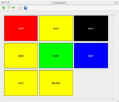|
|
Software |
StoryWeaver
$29.95

A step by
step approach to story development, from concept to completed story for
your novel or screenplay. More than 200 interactive Story Cards guide
you through the entire process.
Details
and Demo
Dramatica
$149.95

The most
powerful story structuring software available, Dramatica is driven by a
patented "Story Engine" that cross-references your dramatic
choices to ensure a perfect structure.
Details
and Demo
Movie
Magic Screenwriter
$149.95

The most
advanced screenwriting software available, Movie Magic is deemed a
"preferred file format" by the Writer's Guild. An industry
standard, MMS is used by professionals and studios around the world.
Details
and Demo
Throughline
Index Cards
$9.95

Interactive
index cards - Name them, add notes, titles, colors, click and drag to
re-arrange, adjust font, save, export and print. An essential tool for
every writer.
Details
Academic
Discounts
on Select Products

Are you a
student, teacher, or academic staffer? Get the very best price on select
products with these manufacturer sponsored academic discounts!
Details

|
| |
Chapter 34
Storyweaving & Storytelling
There are two kinds of storytelling: techniques, those that affect the arrangement of
things (spatial) and those that affect the sequence of things (temporal). In Dramatica
theory, we have cataloged four different techniques of each kind.
Spatial techniques:
Building size (changing scope)
This technique holds audience interest by revealing the true size of something over the
course of the story until it can be seen to be either larger or smaller than it originally
appeared. This makes things appear to grow or diminish as the story unfolds.
Conspiracy stories are usually good examples of increasing scope, as only the tip of the
iceberg first comes to light and the full extent is ultimately much bigger. The motion
picture The Parallax View illustrates this nicely. Stories about things being less
extensive than they originally appear are not unlike The Wizard Of Oz in which a
seemingly huge network of power turns out to be just one man behind a curtain. Both of
these techniques are used almost as a sub-genre in science fiction stories, recently
notable in Star Trek The Next Generation.
Red herrings (changing importance)
Red herrings are designed to make something appear more or less important than it
really is. Several good examples of this technique can be found in the motion picture The
Fugitive. In one scene a police car flashes its lights and siren at Dr. Kimble, but
only to tell him to move along. In another scene, Kimble is in his apartment when an
entire battalion of police show up with sirens blazing and guns drawn. It turns out they
were really after the son of his landlord and had no interest in him at all. Red herrings
can inject storytelling tension where more structurally related weaving may be lethargic.
(Note the difference from changing size, which concentrates on the changing extent of
something, rather than re-evaluations of its power.)
Meaning Reversals (shifting context to change meaning)
Reversals change context. In other words, part of the meaning of anything we consider
is due to its environment. The phrase, guilt by association, expresses this notion.
In Storyweaving, we can play upon audience empathy and sympathy by making it like or
dislike something, only to have it find out it was mistaken. There is an old Mickey Mouse
cartoon called Mickey's Trailer which exemplifies this nicely. The story opens with
Mickey stepping from his house in the country with blue skies and white clouds. He yawns,
stretches, then pushes a button on the house. All at once, the lawn roll up, the fence
folds in and the house becomes a trailer. Then, the sky and clouds fold up revealing the
trailer is actually parked in a junkyard. Certainly a reversal from our original
understanding.
Message Reversals (shifting context to change message)
In the example above, the structure of the story actually changed from what we thought
it was. In contrast, when we shift context to create a different message , the structure
remains the same, but our appreciation of it changes. This can be seen very clearly in a Twilight
Zone episode entitled, Invaders, in which Agnes Moorhead plays a lady alone on
a farm besieged by aliens from another world. The aliens in question are only six inches
tall, wear odd space suits and attack the simple country woman with space age weapons.
Nearly defeated, she finally musters the strength to overcome the little demons, and
smashes their miniature flying saucer. On its side we see the American Flag, the letters
U.S.A. and hear the last broadcast of the landing team saying they have been slaughtered
by a giant. Now, the structure didn't change, but our sympathies sure did, which was the
purpose of the piece.
Temporal techniques:
Building importance (changing impact)
In this technique, things not only appear more or less important, but actually become
so. This was also a favorite of Hitchcock in such films as North By Northwest and
television series like MacGuyver. In another episode of The Twilight Zone,
for example, Mickey Rooney plays a jockey who gets his wish to be big, only to be too
large to run the race of a lifetime.
Non-causality
There is often a difference between what an audience expects and what logically must
happen. A prime example occurs in the Laurel and Hardy film, The Music Box. Stan and Ollie
are piano movers. The setup is their efforts to get a piano up a quarter mile flight of
stairs to a hillside house. Every time they get to the top, one way or another it slides
down to the bottom again. Finally, they get it up there only to discover the address is on
the second floor! So, they rig a block and tackle and begin to hoist the piano up to the
second floor window. The winch strains, the rope frays, the piano sways. And just when
they get the piano up to the window, they push it inside without incident.
After the audience has been conditioned by the multiple efforts to get the piano up the
stairs, pushing it in the window without mishap has the audience rolling in the aisles, as
they say.
Out of sequence experiences (changing temporal relationships)
With this technique, the audience is unaware they are being presented things out of
order. Such a story is the motion picture, Betrayal, with Ben Kingsley. The story
opens and plays through the first act. We come to determine whom we side with and whom we
don't: who is naughty and who is nice. Then, the second act begins. It doesn't take long
for us to realize that this action actually happened before the act we have just
seen. Suddenly, all the assumed relationships and motivations of the characters must be
re-evaluated, and many of our opinions have to be changed. This happens again with the
next act, so that only at the end of the movie are we able to be sure of our opinions
about the first act we saw, which was the last act in the story.
A more recent example is Pulp Fiction in which we are at first unaware that things
are playing out of order. Only later in the film do we catch on to this, and are then
forced to alter our opinions.
Flashbacks and flash-forwards (sneak previews and postviews)
There is a big difference between flashbacks where a character reminisces and
flashbacks that simply transport an audience to an earlier time. If the characters are
aware of the time shift, it affects their thinking, and is therefore part of the story's
structure. If they are not, the flashback is simply a Storyweaving technique engineered to
enhance the audience experience.
In the motion picture and book of Interview With The Vampire, the story is a
structural flashback, as we are really concerned with how Louis will react once he has
finished relating these events from his past. In contrast, in Remains Of The Day,
the story is presented out of sequence for the purpose of comparing aspects of the
characters lives in ways only the audience can appreciate. Even Pulp Fiction
employs that technique once the cat is out of the bag that things are not in order. From
that point forward, we are looking for part of the author's message to be outside
the structure, in the realm of storytelling.
Technique Wrap-up
As long as the audience is able to discern the story's structure by the time it is
over, the underlying argument will be clear. Beyond that, there is no law that says if,
when, or in what combinations these Storyweaving techniques can be brought into play. That
is part of the art of storytelling, and as such is best left to the muse.
The one area we have not yet explored is the impact medium and format have on Storyweaving
techniques. Not to leave a stone un-turned, Dramatica has a few tips for several of these.
Proceed
to the Next Section of the Book-->
How to Order Dramatica:
A New Theory of Story
Back to
the Table of Contents
Back to the Dramatica Home Page
Copyright 1996, Screenplay Systems, Inc.
The Dramatica theory was developed by Melanie Anne Phillips and Chris Huntley
Chief Architect of the Dramatica software is Stephen
Greenfield
Dramatica is a registered trademark of Screenplay Systems Incorporated
Visit
the Dramatica Theory Home Page
Try Dramatica & StoryWeaver Risk
Free*

$179.95
$29.95
*Try either or both for 90 days. Not working for you?
Return for a full refund of your purchase price!
About Dramatica and
StoryWeaver
Hi, I'm Melanie Anne Phillips,
creator of StoryWeaver,
co-creator of Dramatica
and owner of Storymind.com. If you have a moment, I'd like to tell you
about these two story development tools - what each is designed to do, how
each works alone on a different part of story development and how they can be
used together to cover the entire process from concept to completion of your
novel or screenplay.
What They Do
Dramatica is a tool to help you
build a perfect story structure. StoryWeaver is a tool to help you build
your story's world. Dramatica focuses on the underlying logic of your
story, making sure there are no holes or inconsistencies. StoryWeaver
focuses on the creative process, boosting your inspiration and guiding it to add
depth, detail and passion to your story.
How They Do It
Dramatica has the world's only
patented interactive Story Engine™ which cross-references your answers to
questions about your dramatic intent, then finds any weaknesses in your
structure and even suggests the best ways to strengthen them.
StoryWeaver uses a revolutionary new
creative format as you follow more than 200 Story Cards™ step by step through
the story development process. You'll design the people who'll inhabit
your story's world, what happens to them, and what it all means.
How They Work
Together
By itself Dramatic appeals to
structural writers who like to work out all the details of their stories
logically before they write a word. By itself, StoryWeaver appeals to
intuitive writers who like to follow their Muse and develop their stories as
they go.
But, the finished work of a
structural writer can often lack passion, which is where StoryWeaver can help.
And the finished work of an intuitive writer can often lack direction, which is
where Dramatica can help.
So, while each kind of writer will
find one program or the other the most initially appealing, both kinds of
writers can benefit from both programs.
Try Both Programs
Risk Free!
We have a 90
Day Return Policy here at Storymind. Try either or both of these
products and if you aren't completely satisfied we'll cheerfully refund your
purchase price.
Our
Complete Catalog of Products
|

Get
the Writer's Survival Kit Bonus Package
FREE with ANY purchase!
A $300 Value!
|
 |
StoryWeaver
- $29.95
Our
Bestseller! A
step by step approach to story development, from concept to completed
story for your novel or screenplay. More than 200 interactive
Story Cards guide you through the entire process.
|
 |
Dramatica
Pro - $179.95
Includes
2 Exclusive Bonuses! The
most powerful story structuring software available, Dramatica is driven
by a patented "Story Engine" that cross-references your
dramatic choices to ensure a perfect structure.
|
 |
Dramatica
Writer's DreamKit - $49.95
Little
brother to Dramatica Pro, Writer's DreamKit is built around the same
patented Story Engine - it just tracks fewer story points. So, you
develop the same solid story structure, just with fewer details.
Perfect for beginning writers or those new to Dramatica.
|
 |
Power
Structure - $149.95
An
all-in-one writing environment with built-in word processor that helps
you organize and cross-reference your story development materials.
INCLUDES DVD SET BONUS!
|
|

|
Power
Writer - $99.95
The little
brother of Power Structure includes the essential organization and word
processing tools writers need the most.
|
 |
Throughline
- Index Cards (Mac) - $19.95
Interactive
index cards - add notes, titles, colors, click and drag to re-arrange.
An essential tool for every writer.
|
 |
Movie
Magic Screenwriter - $149.95
The most
advanced screenwriting software available, Movie Magic is deemed a
"preferred file format" by the Writer's Guild. An
industry standard, MMS is used by professionals and studios around the
world.
|
|

|
Final
Draft - $199.95
Like Movie
Magic Screenwriter, Final Draft is an industry standard, used by many
professional screenwriters and studios around the world.
|
 |
Between
The Lines (Macintosh) - $29.95
The lowest
cost automatic screenplay formatter for Macintosh includes high-end
features such as interactive index cards linked to your script.
|
|

|
 |
12
Hour Writing Course - $19.95
Everything
you need to know about story structure - twelve hours of video on a
single DVD - presented by Dramatica Theory co-creator, Melanie Anne
Phillips.
|
 |
Dramatica
Software Companion - $19.95
More than
four hours of video demonstrations of every key feature in Dramatica,
narrated by the co-creator of Dramatica.
|
 |
StoryWeaving
Tips Book - $19.95
170 pages of
eye-opening essays on story structure, storytelling, finding inspiration
and a wide variety of writing techniques.
|
 |
StoryWeaving
Seminar 8 DVD Set - $99.95
14 hours of
video from a live two day course taught by theory co-creator Melanie
Anne Phillips covering Dramatica story structure and StoryWeaver
storytelling.
|
 |
StoryWeaving
Seminar Online - $49.95
The same 14
hour program presented in streaming video that you can view online or
download for a permanent copy.
|
 |
Dramatica
Theory 2 Hour Audio Program - $19.95
Every key
concept in the Dramatica Theory of Story is fully explained in this
double-CD set.
|
|

|
Writing
Characters of the Opposite Sex - $29.95
A three-hour
audio CD set that explains everything you need to know to create
characters of both sexes that ring absolutely true (and maybe even gain
insight into the communication problems in the real world!)
|
 |
Master
Storyteller Improves Your Writing - $29.95
Become a
better writing with this series of interactive exercises.
|
|

|
How
to Create Great Characters DVD - $19.95
A 90 minute
video program recorded during Dramatica co-creator Melanie Anne
Phillips' live in-person seminar on story structure and storytelling.
|
|

|
Structure
vs. Passion - Audio CD $19.95
The Story
Mind approach to writing uses your own passions to create your story's
structure. It focuses your efforts, clarifies the direction of
your story, and triggers your imagination.
|
|

|
Writing
with the Story Mind - Audio CD - $19.95
Learn how to
psychoanalyze your story's "mind" to uncover and treat
problems with characters, plot, theme, and genre.
|
|

|
|

|
Academic
Prices - Discounts on Select Products
Are you a
student, teacher, or academic staffer? Get the very best price on
select products with these manufacturer sponsored academic discounts!
|
|

|
Package
Deals - Starting at $49.95
Get deep
discounts with these bundles of our most popular writing products.
|
|

|
Writer's
Survival Kit Bonus Package - FREE!
Free with
ANY purchase - Writing software, online writing workshops, writing
seminars on video, story theory book, and much, MUCH more!
|
| |
|













